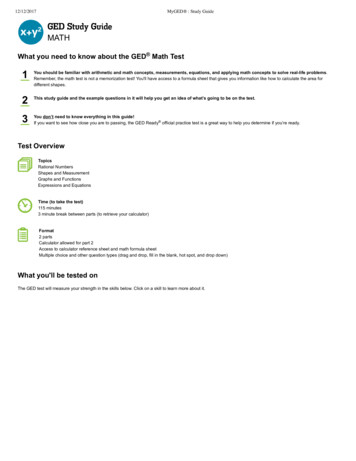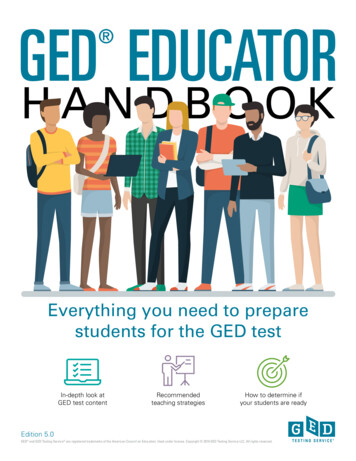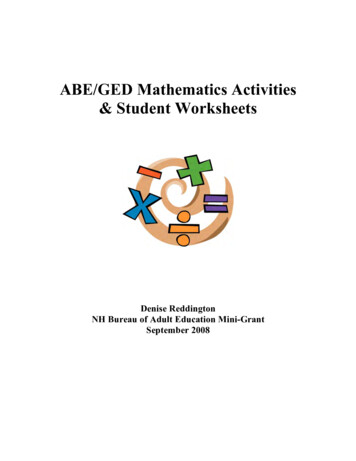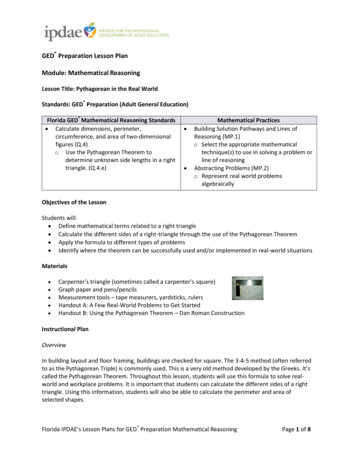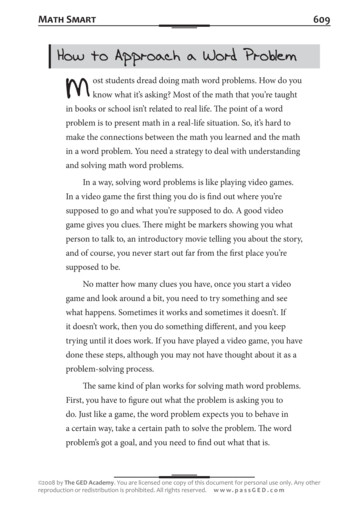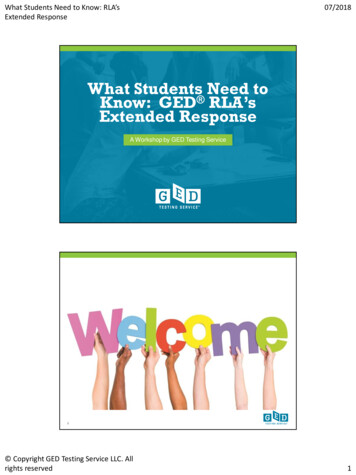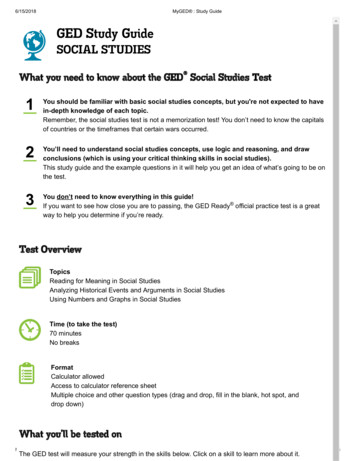
Transcription
6/15/2018MyGED : Study GuideGED Study GuideSOCIAL STUDIESWhat you need to know about the GED Social Studies Test1You should be familiar with basic social studies concepts, but you're not expected to havein-depth knowledge of each topic.Remember, the social studies test is not a memorization test! You don’t need to know the capitalsof countries or the timeframes that certain wars occurred.2You’ll need to understand social studies concepts, use logic and reasoning, and drawconclusions (which is using your critical thinking skills in social studies).This study guide and the example questions in it will help you get an idea of what’s going to be onthe test.3You don’t need to know everything in this guide!If you want to see how close you are to passing, the GED Ready official practice test is a greatway to help you determine if you’re ready.Test OverviewTopicsReading for Meaning in Social StudiesAnalyzing Historical Events and Arguments in Social StudiesUsing Numbers and Graphs in Social StudiesTime (to take the test)70 minutesNo breaksFormatCalculator allowedAccess to calculator reference sheetMultiple choice and other question types (drag and drop, fill in the blank, hot spot, anddrop down)What you'll be tested /guide/SOCIAL STUDIES/printThe GED test will measure your strength in the skills below. Click on a skill to learn more about it.1/24
6/15/2018MyGED : Study udy/guide/SOCIAL STUDIES/print2/24
6/15/2018MyGED : Study GuideReading for Meaning in Social Studies1Main ideas and details in social studies readingsYou'll be presented with social studies passages and be asked to:Determine the main ideasUse details to make inferences or claimsSocial studies passages often make particular claims about a topic and then provide detailsthat the author uses to support the assertions made.Social studies readings may be from a primary source (created by someone with firsthandknowledge of an event) or a secondary source (created by someone at a later time who didnot have firsthand knowledge of the event). Sometimes these documents are complex orwritten in an "old-fashioned" style, and it takes skill to read and understand what the mainpoint or points of the reading are - which might not be obvious to you on the first read.For example, a reading about American History might argue that the cause of the AmericanRevolution was the unfair taxation of the American colonies. The reading might thenprovide details or examples of unfair taxation that support the author's position.Or, you might read an excerpt of a letter written by a soldier during the U.S. Civil War. Thisprimary source document explains the perspective of that individual and what he was doingor experiencing at the time. As a reader, your task might be to explain or summarize themain points or theme of what the soldier was trying to communicate.Example QuestionsMain ideas and details in social studies readingsThis excerpt is from the "Declaration of Sentiments" presented to the Seneca FallsConvention by Elizabeth Cady Stanton in 1848.We hold these truths to be self-evident: that all men and women are createdequal; that they are endowed by their Creator with certain inalienable rights; thatamong these are life, liberty, and the pursuit of happiness; that to secure theserights governments are instituted, deriving their just powers from the consent ofthe governed. Whenever any form of Government becomes destructive of theseends, it is the right of those who suffer from it to refuse allegiance to it, and toinsist upon the institution of a new al#/study/guide/SOCIAL STUDIES/print3/24
6/15/2018MyGED : Study GuideQuestion:What concept is a main idea of this excerpt?AnationalismBnatural rightsCimperialismDmajority dy/guide/SOCIAL STUDIES/print4/24
6/15/2018MyGED : Study Guide2Social studies vocabularyYou'll be presented with social studies passages which include common social studiesterms and phrases.For example, the term "capitalism" describes the main economic system that is in place inthe U.S. You may need to be able to understand what that term means in order todistinguish it from other economic systems, such as "socialism" or "communism."Example QuestionsSocial studies vocabularyThe chart below describes the four methods used to amend the U.S. Constitution.Four Methods of Amending the U.S. ConstitutionStep 1Step 21.A two-thirds vote in both houses of theU.S. CongressRatified by three-fourths of thestate legislatures2.A two-thirds vote in both houses of theU.S. CongressRatified by ratificationconventions in three-fourths ofthe states3.A national constitutional conventioncalled by two-thirds of the statelegislaturesRatified by three-fourths of thestate legislatures4.A national constitutional conventioncalled by two-thirds of the statelegislaturesRatified by ratificationconventions in three-fourths ofthe statesThe 17th AmendmentThe 1787, delegates to the Constitutional Convention decided to give statelegislatures the power to select U.S. senators. The purpose was to ensure thatthe interests of the states were represented in that national legislature. However,some argued that the people should directly elect their senators. They thoughtthe interests of the states would be preserved because the people were thesource of all government tudy/guide/SOCIAL STUDIES/print5/24
6/15/2018MyGED : Study GuideThe first of nearly 300 congressional resolutions calling for direct election ofsenators came in 1826. Over the next 85 years, an amendment to directly electU.S. senators was debated extensively. Finally, in 1913, the 17th Amendment,which allowed for the direct election of senators, was ratified.Question:What does the word convention mean in both the chart and The 17th Amendmentpassage?Acultural traditionBformal assemblyCagreed-upon contractDpreferred writing udy/guide/SOCIAL STUDIES/print6/24
6/15/2018MyGED : Study Guide3How authors use language in social studiesYou'll be asked to identify how authors use language, (for example, imagery or facts) toestablish their points of view or purpose.Social studies authors use language to support their arguments in a variety of differentways. One author might use facts to create an argument, while another might usemetaphors to create more of an emotional argument.For example, an author writing about competition in the communications industry might citefacts about company revenues, profits, or market share. Another writer discussing theeffects of competition on cell phone prices might provide examples of how consumers feltabout their treatment by cell phone service providers. These authors have differentpurposes and use different kinds of language to support their purposes. As a reader, it isimportant to be able to identify the different characteristics of writing in order to be able tounderstand and evaluate the meaning of the passage.Example QuestionsHow authors use language in social studiesThis excerpt is from President Barack Obama's 2017 farewell address.Our democracy is threatened whenever we take it for granted. . . . When votingrates in America are some of the lowest among advanced democracies, weshould be making it easier, not harder, to vote. When trust in our institutions islow, we should . . . insist on the principles of transparency and ethics in publicservice. When Congress is dysfunctional, we should draw our congressionaldistricts to encourage politicians to cater to common sense and not rigidextremes.But remember, none of this happens on its own. All of this depends on . . . eachof us accepting the responsibility of citizenship, regardless of which way thependulum of power happens to be swinging.Our Constitution is a remarkable, beautiful gift. But it's really just a piece ofparchment. It has no power on its own. We, the people give it power. We, thepeople, give it meaning. . . . Whether or not we stand up for our freedoms.Whether or not we respect and enforce the rule of law. That's up to us. Americais no fragile thing. But the gains of our long journey to freedom are not /study/guide/SOCIAL STUDIES/printQuestion:7/24
6/15/2018MyGED : Study GuideBased on the excerpt, which phrase identifies an unstated purpose of PresidentObama's speech?Ato encourage support for the incoming administrationBto gain support for the newly elected members of CongressCto convince his audience to actively participate in governmentDto convince his audience to be honest when dealing with rtal#/study/guide/SOCIAL STUDIES/print8/24
6/15/2018MyGED : Study Guide4Fact versus opinionYou'll be asked to determine when an author is using factual statements or inferences, asopposed to opinions.For example, an author might begin with the opinion that the 1960s were one of the mostdifficult and divided times in American history. They may go on to cite evidence or facts thatdescribe the Vietnam War, civil rights protests, and the Cuban Missile Crisis.Example QuestionsFact versus opinionIn January 1991, President George H. W. Bush made a speech about Iraq's invasionof Kuwait.Question:Which statement from President Bush's speech is an opinion?A"The United Nations, with the full support of the United States, hasalready tried to peacefully pressure Iraq out of Kuwait . . . ."B"And our own economy is suffering . . . the effects of higher oil pricesstemming from Saddam's aggression. . . ."C". . . [E]conomic sanctions are taking a toll, but they are still notforcing Saddam out of Kuwait. . . ."D"We have seen too often in this century how quickly any threat to onebecomes a threat to udy/guide/SOCIAL STUDIES/print9/24
6/15/2018MyGED : Study Guide5Claims and evidence in social studiesYou'll be presented with social studies passages and be asked to:Determine whether a claim is or is not supported by evidenceCompare information that differs between sourcesFor example, you might be provided with a passage that discusses the historical expansionwestward of the United States in the 19th century and that argues that the expansion wasbeneficial to the Native American people who had occupied the land previously. Thereading might provide evidence to support that claim and your task could be to evaluatewhether it does. You might also be asked to read information from different sources andanalyze whether the differing versions are credible in supporting the claims that are made.Example QuestionsClaims and evidence in social studiesThis paragraph is paraphrased from Federalist No. 84, an essay by AlexanderHamilton, published in 1788.Hamilton's EssayNot only is a bill of rights unnecessary, I am sure that in the proposedconstitution it would even be dangerous. Why declare that things will not bedone when there is no power to do them? Why assert that certain rights areprotected when the government has no power to violate those rights? Why statethat there is freedom of the press when the government is not given power thatcan be used to violate freedom of the press? It would only provide an excuse forpower-hungry men to claim such a power.This paragraph is paraphrased from a letter written by James Madison to ThomasJefferson in 1788.Madison's LetterI have always favored a bill of rights, so long as it does not imply that thegovernment has powers it is not meant to have. At the same time, I do not thinkthe absence of a bill of rights is a major defect. The real threat to individualrights is not the government, but a strong-willed majority of the people.Nevertheless, the threat may occasionally come from the government, in whichcase a bill of rights will be essential. It is a sad truth that freedom is endangeredwhether the government has too much or too little power, and finding the dy/guide/SOCIAL STUDIES/printline between the extremes is not easy.10/24
6/15/2018MyGED : Study GuideQuestion:How does Hamilton's essay differ from Madison's letter?AOnly Hamilton suggests that governments might abuse power.BOnly Hamilton argues that no other constitution contains guaranteesof individual liberty.COnly Hamilton says that a bill of rights is acceptable as long as itdoes not give unintended power to the government.DOnly Hamilton says that a bill of rights would damage the safeguardsof liberty the proposed tal#/study/guide/SOCIAL STUDIES/print11/24
6/15/2018MyGED : Study GuideAnalyzing Historical Events and Arguments in Social Studies1Making inferencesSocial studies authors often use evidence to guide the reader to draw conclusions.You'll be asked to make inferences or draw conclusions by applying your logic andreasoning skills to the evidence presented in social studies readings.For example, you may be provided with several pieces of evidence about a particularhistorical event and then infer what the most likely outcome might be in the future.Example QuestionsMaking inferencesA recent magazine article examined government in the United States during the firstdecades after independence from Britain.Question:Which quotation from the article allows a reader to infer that the power of the U.S.government is limited?A"A fear of tyranny led to the creation of a national government underthe Articles of Confederation, which lasted less than a decade."B"As a result, the founders drafted the U.S. Constitution, whichaddressed weaknesses of the Articles of Confederation."C"The U.S. Constitution, ratified over two hundred years ago, greatlychanged the relationship between the national and stategovernments."D"The U.S. Constitution included safeguards to protect individual rightsagainst abuse by the tal#/study/guide/SOCIAL STUDIES/print12/24
6/15/2018MyGED : Study Guide2Connections between different social studieselements (people, events, places, processes)You'll be asked to:Analyze cause-and-effect relationshipsDescribe the connections between people, places, environments, processes, andeventsPut events in order and understand the steps in a process (for example, how a billbecomes a law)Analyze the relationship of events, processes, and/or ideas. For example, you mightanalyze whether earlier events actually caused later ones or simply occurred beforethem.Taking another example, an author writing about WWI might cite events leading up to thewar, including political and social events. In the years prior to WWI, social unrest, fueled byfood shortages, led to riots. Deposed Russian leadership left a dangerous power vacuum.At the same time, increasingly aggressive clashes arose between world empires.In these passages, you will be provided with the historical facts. You will be asked todetermine the connections between them.Example QuestionsConnections between different social studies elements (people, events,places, processes)Reconstruction PoliciesAfter President Lincoln's assassination in April of 1865, President AndrewJohnson and the Radical Republicans in Congress battled for control ofReconstruction. The battle included setting the conditions for formerConfederate states to be readmitted to the Union. President Johnson wantedeven milder conditions than those that had been proposed by Lincoln. TheRadical Republicans demanded policies that punished the South and ensuredcivil rights for African Americans.By 1866, enough Radical Republicans had been elected to Congress to overrideJohnson's vetoes. Over the next two years, Congress passed a series ofReconstruction Acts. All the former Confederate states, except one, were placedunder military control. These acts also required each state to accept the 14thand 15th Amendments, which granted political and voting rights to AfricanAmerican men. It was under these conditions that the remaining Confederatestates returned to the portal#/study/guide/SOCIAL STUDIES/printWhich event in the passage happened second?13/24
6/15/2018MyGED : Study GuideACivil and political rights were granted to African American men.BRadical Republicans in Congress took control of Reconstruction.CPresident Lincoln proposed mild conditions for states to rejoin theUnion.DRadical Republicans and President Johnson disagreed overReconstruction #/study/guide/SOCIAL STUDIES/print14/24
6/15/2018MyGED : Study Guide3The effect of different social studies concepts on anargument or point-of-viewAll social studies authors have a point of view and purpose for what they write.You'll be asked to:Analyze how events and situations shape the author's point of viewEvaluate whether the author's evidence is factual, relevant, and sufficientMake judgments about how different ideas impact the author's argumentFor example, an author might present their point of view that non-violent approaches arethe most effective way to impact government policy. They could present evidence from themovement to resist British rule in India, led by Mohandas Gandhi, alongside evidence fromthe American civil rights movement in the United States, led by Martin Luther King, Jr.Example QuestionsThe effect of different social studies concepts on an argument or point-ofviewMuch of the 20th century was marked by conflict between the ideas of communismand capitalism.Question:Which term is associated with the ideas of communism?Aprofit motiveBprivate propertyCclassless societyDcompetitive tudy/guide/SOCIAL STUDIES/print15/24
6/15/2018MyGED : Study Guide4Identifying bias and propaganda in social studiesreadingsYou'll be asked to identify when a social studies reading uses bias or propaganda.Sometimes authors promote their point of view by appealing to a reader's emotions. Theycan use loaded language (words that trigger emotions) to lead the reader to the author'spoint of view.For example, during the Cold War, as tensions rose between the U.S. and the SovietUnion, many Americans worried that communism could destroy American society. Thisworry was fueled by writings describing communism as an "iceberg that could sinkAmerica" or as "purgatory under Communism."Example QuestionsIdentifying bias and propaganda in social studies readingsQuestion:Which publication is the best example of propaganda?Aa website that lists the federal taxes paid by individuals at differentincome levelsBa newspaper article that quotes a senator who argues that federalincome taxes are too highCa wartime cartoon that claims American citizens who fail to pay taxesare helping the enemyDa pamphlet written by a socialist group that describes the history oftaxes on wealthy American /study/guide/SOCIAL STUDIES/print16/24
6/15/2018MyGED : Study GuideUsing Numbers and Graphs in Social Studies1Using data presented in visual form, including maps,charts, graphs, and tablesData can be represented in many different visual forms, including charts, tables, graphs,maps, photographs, and cartoons.You'll be presented with data in visual form and will be asked to:Make sense of information that is presented in different waysAnalyze information from maps, tables, charts, photographs, and political cartoonsRepresent textual data into visual form (charts, graphs, and tables)Interpret, use, and create graphs with appropriate labeling, and use the data to predicttrendsFor example, a line graph can show the population growth of a city before and through theIndustrial Revolution. You may be asked to predict future growth for the city.Example QuestionsUsing data presented in visual form, including maps, charts, graphs, andtablesThe information in the graph is from the U.S. Senate /study/guide/SOCIAL STUDIES/printQuestion:17/24
6/15/2018MyGED : Study GuideWhich session of Congress had twice as many women representatives as the tstst1.pearsonvue.com/portal#/study/guide/SOCIAL STUDIES/print18/24
6/15/2018MyGED : Study Guide2Dependent and independent variablesA variable is simply a person, place, or thing you are trying to measure. Some variablesimpact other variables.You'll be presented with a graph showing independent and dependent variables, and willbe asked to analyze and show how they are related to each other.For example, a graph can show the number of people and the food consumption in a town.The number of people is the independent variable. The number of people that will impactthe food consumption is the dependent variable. More people will result in more foodconsumption.Example QuestionsDependent and independent variablesThis excerpt is from an article published by the U.S. Environmental ProtectionAgency (EPA).Since the Industrial Revolution began around 1750, human activities havecontributed substantially to climate change by adding CO2 and other heattrapping gases to the atmosphere. These greenhouse gas emissions haveincreased the greenhouse effect and caused Earth's surface temperature to rise.The primary human activity affecting the amount and rate of climate change isgreenhouse gas emissions from the burning of fossil fuels. . . .Human activities currently release over 30 billion tons of CO2 into theatmosphere every year. The resultant build-up of CO2 in the atmosphere is like atub filling with water, where more water flows from the faucet than the drain cantake away.Question:Which graph represents the relationship discussed in the tal#/study/guide/SOCIAL STUDIES/print19/24
6/15/2018MyGED : Study udy/guide/SOCIAL STUDIES/print20/24
6/15/2018MyGED : Study Guide3Correlation versus causationYou'll be asked to recognize the difference between correlation and causation betweenevents.For example, you may be presented with a passage describing the significant growth of acity. The passage could include facts about industrial innovations, including the assemblyline and factories. You may also be presented with information about medicaladvancements.You'll use the data provided to determine the direct relationship (causation) between theindustrial innovations and urban population growth. However, there may not be evidence ofa direct relationship between the medical advancements and urban population growth (acorrelation).Example QuestionsCorrelation versus causationRebellion in the Thirteen ColoniesIn 1775, tensions were high between Britain and the American Colonies. TheFrench and Indian War ended more than a decade before, but its effects had notceased.The French and Indian War brought the colonies together in unexpected ways.Having fought in and helped to win the war, Americans experienced a newsense of unity, apart from Britain. Also, the war increased British debts. To helppay these debts, Parliament placed new taxes on the colonies.Outraged that they were expected to bear the cost of a war that had started inEurope, colonists protested. Some simply refused to pay taxes to a parliament inwhich they had no representation. In response, Britain sent additional soldiersand tensions increased. American Patriots prepared for war.In April 1775, the Crown sent troops to Massachusetts to locate Patriot leadersand stockpiled weapons. At Lexington and Concord British troops and Americanmilitia exchanged gunfire. The Revolutionary War had begun.Question:Which statement represents a cause-and-effect relationship?ABecause the colonists refused to pay the new taxes, they preparedfor dy/guide/SOCIAL STUDIES/print21/24
6/15/2018MyGED : Study GuideBBecause Britain had accumulated war debts, it imposed new taxeson the colonists.CBecause they had fought in the French and Indian War, colonistsrefused to pay taxes.DBecause colonists protested taxes, British soldiers fired on them atLexington and /study/guide/SOCIAL STUDIES/print22/24
6/15/2018MyGED : Study Guide4Using statistics in social studiesYou'll be asked to find the mean, median, mode, and range of a data set.For example, you may be presented with the population of all of the counties in a state.You may be asked to calculate the mean, median, mode, and range of the poplations of thestate's counties.Example QuestionsUsing statistics in social studiesThe information in the table is from the United Nations.Largest Urban Areas By Population, 2007Urban AreaEstimated Population (millions)1. Tokyo, Japan35.62. Mexico City, Mexico19.03. New York, United States19.04. Mumbai, India18.95. São Paolo, Brazil18.8Question:What is the range in the population of the five urban areas in the table? You may usethe calculator.A9.5 millionB16.8 millionC19.0 millionD22.26 study/guide/SOCIAL STUDIES/print23/24
6/15/2018MyGED : Study udy/guide/SOCIAL STUDIES/print24/24
SOCIAL STUDIES What you need to know about the GED Social Studies Test 1 You should be familiar with basic social studies concepts, but you're not expected to have in-depth knowledge of each topic. Remember, the social studies test is not a memorization test! You don’t need to know the
